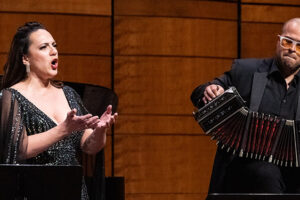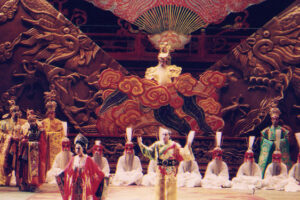

It is a staging rife with many fine points and details—not all of which worked—that served—crucially—to make this intimate drama come to life. Facial expressions and movements are especially important to appreciating the exceptionally fine, even revelatory performance I saw this warm Saturday afternoon; I can’t imagine the small, subtle touches registering from afar in the nearly 4000-seat opera house.
In other words the cinematic approach abetted the performance. Too, the subtitles greatly increased understanding of what was being sung (I have long memorized the text and absorbed it, but not being able to organically think in Italian, the subtitles kept me understanding at a glance, of what was going on).
I firmly depart, though, with the majority of negative reviews accorded this updating of Bellini’s masterpiece. “Updating”? Yes. This is very much a production and approach needed for this day and age.
It may be the best directed staging of Norma I have ever seen. The previous night, looking through on YouTube through various recent and vintage productions, I was struck by the unbelievable badness of a high number of them, their stagings, direction and concepts presented: old-hat, turgid, static, and numbingly boring. Abnorma, Pollinator, Analgesia and Orotundo, if they are not sufficiently developed, can come across as stock old sticks.
Not here, though.
Gone is the chiffon, organza, lace, and flowered headgear. What this production and staging imparted was of a weary, ragged lot that are the tribe of the Druids, hiding out in a grimly oppressive, dark, and claustrophobic forest, with only pallid flecks of light dappling through the trees.
Norma’s secret dwelling, in which she hides her sins and children from the world, provides a domestic abode that is completely convincing, as it has all the effects one might have in such a situation (save for that prop Wild West wagon wheel…). The sets are purely cinematic, and the costumes look as if they came straight out of Braveheart-Robin Hood-styled epics. This is a rough, rugged motley crew of people, and they look (properly) as if they’re lacking fashion designers and hairdressers.
Gone is the stand-and-sing-only-to-the-audience approach. Gone is the quaint taint of “tasteful,” restrained, stately, contained gentility. Bellini and Romani’s drama is about violent emotions in a musically Classical mode (the “Guerra!” chorus alone should dissuade any notions that Bellini was a “gentle Sicilian:” it is of a startling, brutal ferocity that has no equal in any other opera).
It is about a woman who betrayed her tribe by having sex with a man on the side of the enemy, bearing two children, whom she keeps out of view. The father of her children starts an affair with his lover’s best friend. Thwarted mother threatens suicide, and asks her best friend to be the mother of her children, as well as intending to avenge her hurt by declaring war on the Romans.
After coming close to killing her lover and intending to lie about her best friend’s treason, mother instead confesses her own treason and sins, and sacrifices herself to burn to death, in which her lover joins her, and leaving her children orphaned. How often and how indelibly are these factors ever put across in any staging of Norma we’ve ever seen?
Right here, in this one.
For once, I gather that Romani’s libretto has been used as a main source of reference here. It is not only poetic, but keen on psychological detail. Read the text, I say, to understand the approach taken here. Quite often these details get lost in service to the music, but McVicar has evidently studied the text and implemented it with unerring skill.
What the directorial vision made manifest is the sheer, convoluted messiness of love, betrayal, and treason. This is the most tightly directed triangle affair of the story I have ever seen. All of the performers are made to interact with each other in a very conscientious manner, and it often works with arresting effectiveness. You see them physically reacting to each other, the text actually registering in their mutual responses; good acting is reacting, and it is especially well done here.
As I mentioned earlier, this staging concerns itself with the haphazard, dysfunctional themes of love, its neuroses, its masochism, and indecisiveness. Pollione upbraids Adalgisa in their duet (the import of his words, “Va, crudele! registers here), and practically bullies her into submission, and then, woos her most persuasively in “Vieni in Roma.” I particularly liked, during the trio finale of act one, where Pollione, defiant, looms threateningly over Norma as she’s sitting on her bed, and she pulls away from him as it to say, “Back off, creep!”
After all, Pollione is a warrior, and it stands to reason he’s not gonna readily let himself be a pushover to some woman. In their big confrontation in the duet “In mia man,” you see depicted the one-upmanship, the lovers-spat violence and irony of the words they fling at each other, and a keen sense that this couple has had a history together; moreover, that they’re not finished. The scene has dark, disturbing undertones of violence.
After Norma’s confession, she frees Pollione from his restraints, and you’re made to see—convincingly—that he is deeply touched by her nobility, and as they stand together during “Qual cor tradisti,” clinging to each other for support—while still in accusation mode, mentioning old wounds of hurt—it for once makes sense that they are bound together, and will die together.
They’re both guilty and penitent, and a suicidal death is their only recourse. As directed, and as enacted by Sondra Radvanovsky and Joseph Calleja, it is deeply powerful, terrifically moving stuff. Where before in any staging has one ever seen Norma and Pollione so physically intertwined and close? Usually, Pollione is standing off to the side, muttering to himself.
Watching this scene, and reading the subtitles, the deep underpinnings of Romani’s words, the drama has not only meaning, but sense. I also liked having Adalgisa watch, forlornly, as Norma and Pollione walk up to the pyre. It makes no sense now that she should disappear at the end.
I have never seen a staging where Pollione is made to be such a swaggering, macho brute; he is very much the intrepid, vigorous Roman warrior. This is a lusty, vital man, yet capable of tenderness, and finally, humility and redemption. Nowhere else, either, have I ever seen depicted such a troubled, conflicted Adalgisa.
You fully understand, here, her triple dilemma: being in love with her friend’s lover; the troubled departure from her tribe and chastity; and being asked to be her best friend’s surrogate parent. For once, Pollione and Adalgisa are successfully moved from being stock figures to major participants in the drama of Norma, who gets all the best music and lines.
McVicar, one senses, refuses to have Pollione and Adalgisa residing passively off to the sidelines, in deference to Norma; the motivic intentions for her decisions and choices are for once made strongly manifest here. Without convincing antagonists to play off of, Norma frequently becomes a one-woman show; McVicar has seen to it here that it doesn’t!
Not all of the directorial touches worked; Norma is made to enact her opening scene first laying down, then on her knees, disheveled, flopping around and gesticulating wildly, as if preparing for a Mad Scene. She cowers in a tree hollow during the last part of “Ah! bello a me ritorna.” (You might be able to sense a motivation there: expressing her agitated private thought about her love for Pollione, she could be worried her “asides” are becoming obvious).
There are a few distracting instances of candles being lighted that actually upstage the performers, as you can’t help but watch them fiddling with getting the damned things lit. Still, there is an intent here: to prevent this nearly action-less drama from being turgid and static.This results from some of the best work I have seen from all the singers involved.
Oroveso is one of the most thankless and unrewarding roles in the bass repertoire. His music is entirely conventional, and doesn’t really give the singer a real chance to distinguish himself. The opening to the opera provides a suitable lead-in to the proceedings, but the give-the-Norma-a-rest-before-her-big-closing-scene interlude “Ah, del Tebro” stops the drama in its tracks (Bellini had intended to revise Oroveso’s music at some point, but fate—his own premature death—precluded him from doing so.
It is tempting to speculate on an effective father-daughter duet that might have been implemented). Nevertheless, Matthew Rose compensates by investing his words and phrasing with authority and vigor; tall and a commanding figure on the stage, his contribution, notably at the end, provides the drama with the necessary gravitas. My reservation concerns Rose’s voice, which is low-placed and throaty rather than resonant and ringing.
I came away with an entirely affirmative reaction to Calleja’s Pollione. Contrary to reports of his being wooden, I found him compelling and involved. His opening number, “Meco all’tar di Venere” was unusually well-sung and nuanced; Calleja registered both in his phrasing and physical expression what he was communicating. His plangent, buzzy tone, so unique and “old-tyme” in quality, is firm and steady, and his pingy Latin vowels are a real pleasure.
Calleja is less at ease, though, with the bumptious, brash cabaletta, “Me protegge,” which is a forgettable, thumping, and undistinguished tune anyway. Only one verse is sung, which is just as well. Calleja positively shines in the opera’s last 20 minutes, making Pollione as more than just a one-dimensional lunkhead.
Joyce DiDonato’s Adalgisa, high-strung, nervous, and tormented, is perhaps the best-acted in memory. Marvelously responsive to her co-stars and the dramatic situation, she is alert, focused, and throughly immersed in her characterization. Her conflict—love for Pollione, loyalty to her best friend—is “sent over” with genuine agony, and the burgeoning realizations of what she’s faced with are put across with startling vividness.
Vocally, one might have heard Adalgisas with more purity of tone, more ease at the top of her range, more smooth poise in the long lines, but few have ever exhibited the import of the text, and crucial lines as this star mezzo does (then again, DiDonato has a far more fitting tonal makeup than the scores of burly, beefy mezzo-contraltos—Elena Nicolai and Elena Obraztsova as sweet young thangs?— who’ve sung what is essentially a soprano role; too, a Carmen-Amneris-Azucena tonal color is not exactly apt for a young vestal virgin).
Most of all, how rewarding it is to see Adalgisa depicted as so complex a character! Physically, histrionically, and vocally, DiDonato’s Adalgisa is one of the most astutely realized I have ever seen.
Radvanovsky in the title role completely won me over with her performance. I reckon this to be the finest work she’s ever done. Though I earlier mentioned being displeased with Norma’s opening blocking, she gives it all she’s got and doesn’t at all shirk the moves she’s been given to do. Throughout, the soprano was convincing at every turn. She is visibly and audibly responsive to the dramatic situation, and her hard work and sincerity really pays off, and this is exactly the kind of direction she needs.
In Norma’s second scene, onto the end of the act in her secret dwelling, Radvanovsky successfully runs the gamut from tired, frustrated mother, to warm, supportive friend, to an angry woman scorned. The relationship to the children is especially played up here and Radvanovsky is entirely believable, and very touching.
Radvanovsky reaches genuine heights of tragedy in the opera’s last half hour. Physically and vocally, the soprano has never appeared so confident, so inner-directed in response to Norma’s situation; the priestess’s world is closing in on her, and Radvanovsky exhibits all the myriad emotions with gripping skill.
Vocally, the soprano is as she has always been: for the most part secure, with a few inconsistent spots. Perhaps inspired by McVicar’s direction, her recitatives have greatly improved, having more alertness and specificity of meaning. The voice is most outstanding when singing the long, lyrically elegiac lines, nowhere more so than in the last 15 minutes, which is filled with the most generously expansive outpouring of tone.
Earlier, “Casta diva,” “Oh, rimembranza” to the lyrical sections of the duets, to the “Dormono entrambi,” to the “Teneri figli,” are done with musical sensitivity and luxuriance of legato and tonal splendor.
I have accepted the fact that fast, accurately sung and ease of passagework will never be, a la Sutherland, a top feature of Radvanovsky’s work—though the latter is far better than past legions of dramatic verismo sopranos lumbering and screeching their way through. Possibly due to Radvanovsky’s laryngeal vocal production, intervallic leaps find her dragging, rather then springing up to the upper notes.
On my wish list: a more concentrated, clipped approach to consonants; “Casta diva” registers somewhat as “Casta-iva.” Vowels that have more Italianate purity and integrity; “madre,” for example, sounds like “madree.” Also; as one hears, Radvanovsky has in her a nice, pungent chest tone, as in “morra” in the opening recitative, and “dubbio” in her scene with Clotilde. Yet, one wonders why, in the pivotal duet with Pollione, “In mia man,” the “Adalgisa fia punita,” written low, on trills, is barely audible.
Finally, and this is a risky thing to even suggest: more clarion, forward resonance would be welcome, particularly in the higher regions of the voice; the graininess of tone, so alluring in the middle register, becomes tight and pressured at forte, the vibrato becoming narrow and accelerated.
It is important to note, though. Hearing Radvanovsky only aurally on the opening night web livestream versus seeing and hearing her in the HD moviecast is to garner an entirely different impression altogether. In the visual presentation, you don’t notice the less-felicitous drawbacks of the vocalism itself, and I suspect that aspect is in even greater in the house, where Radvanovsky’s singing is said to have an enormous impact. As it is, she left me impressed, deeply moved, and very much admiring of her performance as a whole.
I thought that Carlo Rizzi, the conductor, did an outstanding job of delivering the score. By that I mean, it was in service of accompanying the singers, while keeping the dynamics sensibly and sensitively under control. The Metropolitan Opera orchestra, in a piece like this, is luxury casting indeed.
The chorus and supers had much to do in this production besides the usual ludicrous standing around and commenting on the situation; they were made to be part of the drama too, quite excitingly at times.
The interest for me in this performance was the reinstatement of several, traditional cuts. The first Norma/Adalgisa duet’s “extension” was first heard on the first Sutherland/Horne recording; ditto for the Act One trio “Oh! Di qual sei vittima,” which restored Adalgisa’s statement directly following Norma’s, and, as well, extending the scope of it: this should be from here on the version used.
Also restored was the slow maggiore section following the “Guerra!” chorus, along with Norma’s upward arpeggio at the close. The biggest surprise though, came in the prelude to Act Two. The con dolore melody with cello, usually played just once, was repeated here, but with the clarinet and flute joining the cello—a most striking and beautiful effect, too fine to be lopped off.
Yet—yet! The concluding bars of act one were trimmed, as was the last bars of “In mia man.” Pollione’s cabaletta was cut to one verse.
Then, on the opening night livestream a moment of true confusion occurred. It has become customary to transpose the second act’s duets “Deh! con te… Mira o Norma,” in the score keys of C and F, to, respectively, down to B flat and E flat. So, “Deh! con te” in this performance starts in the original key… but then, when Adalgisa begins her statement, it is lowered to B flat, then it is put up again to F for “Mira o Norma.”
This subterfuge intially completely threw me off and messed with my mind, until a musically well-trained friend messaged me of the devious trick. I have no objections; DiDonato obviously had decided the section was too high for her, and better that than hearing it severely pressed.
Despite the inconsistencies that never seem to escape any operatic performance, this staging of Norma was a complete revelation to me. I have developed an entirely new perspective on how this, my favorite opera, could be further enhanced in terms of how it is presented—more human, more psychologically deep, and more complex than has been previously allowed.
Photo: Ken Howard/Metropolitan Opera
























Comments